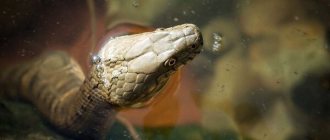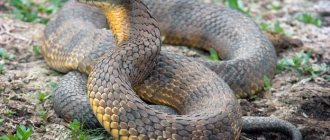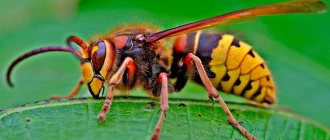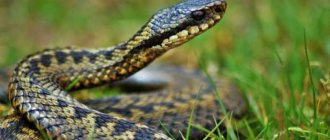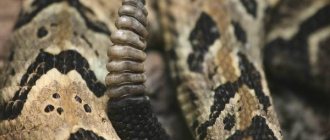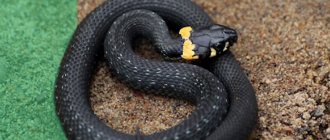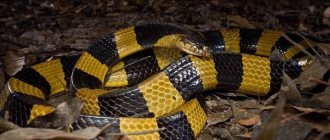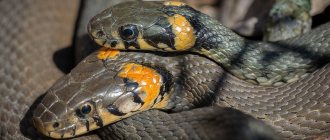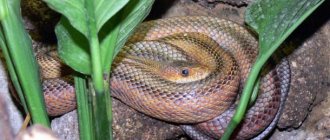Sea snakes are frequent heroes of sailors' stories. While traveling in the fleet, sailors often encountered mysterious monsters.
So, having arrived from another trip, the sea wolf invited hundreds of people with his stories. Some of the listeners were terribly scared and ran away, while the other half, on the contrary, wanted a meeting.
What are sea snakes? This article will tell you about their types and features.
Appearance of sea snakes
The color of reptiles is almost always bright. However, you can also find a black sea snake. At the ends of the predator there are visible rings of different shades.
Most sea snakes do not have a ventral scute. Scaly skin is easily visible: each scale is separated from the other. Reptiles vary in body shape.
Typically, sea snakes have a narrow head and a slightly elongated body. Thanks to the small cervical region, it is much easier for predators to catch prey. Other distinctive features are noticeable in photos of sea serpents.
Breathing Features
It has been proven that sea snakes breathe through skin penetrated by blood capillaries. Despite the fact that the predator has thick scales, 25% of the oxygen necessary for life is absorbed through it. Thus, the reptile can stay under water for 1.5-2 hours. However, these reptiles do not have gills, which is why they are still forced to rise to the surface to breathe. To do this, the snake exposes only the tip of its head with nostrils from the water. When diving, they close, which prevents water from entering the respiratory tract.
The right lung of the snake is extended along the entire length of the body, right up to the tail. It also acts as an air and swim bladder reservoir.
Underwater, the reptile can absorb oxygen through the mucous membrane of the oral cavity.
Due to the structure of the respiratory tract, the animal cannot hiss, but instead makes gurgling and gurgling sounds.
Flat-tailed
Another group of sea snakes are flat-tailed snakes. Their numbers are significantly smaller. Flat-tails, unlike swallowtails, lay their eggs on land. They can also be found not only in the seas and oceans, but also on Solomon Island.
Flattails did not always live in water. According to the results of the study, representatives of the group gradually changed their environment. Perhaps they did this several times.
Where and when snakes were born remains in question. It is believed that this event occurred about twenty million years ago in Australia or Asia.
Note!
Domestic turtles - the most popular species, cultivation features, tips for care and maintenance (115 photos + video)- Indian snakes: sacred, poisonous, most common and dangerous types of Indian snakes and their names (130 photos)
Small snakes - an overview of popular and rare species, habitats, food and names of snakes (115 photos)
Reproduction
Most species of sea snakes produce offspring once a year. The male has two penises at once (the so-called hemipenises), but during the mating process he uses only one. The process itself can take quite a long time, so the reptiles have to go up to breathe. At this moment, the male is attached to the female by the hemipenis, and until mating is over, he will not be able to separate from her.
Some species of sea snakes have a courtship process. For example, in the tortoiseshell and olive snake, the male pursues the female and touches her neck and head. During the breeding season, sea snakes can form aggregations that stretch for tens of kilometers.
Pregnancy (depending on the type of reptile) lasts from 4 to 11 months. Females even form some kind of placenta. Perhaps because of this, the cubs are born large, sometimes reaching half the length of their mother. However, there are only 1-2 small snakes in a litter.
They are born tail first so as not to choke, and immediately wrap themselves around the back of the material. Young individuals will live in the lagoon for several months, after which they move to deeper places. At first, a mother takes care of her children. After two years they reach sexual maturity. The total lifespan of a sea snake is 10 years.
However, not all of them are viviparous: for example, flat-tailed fish lay eggs. The mating process also takes place on land, in shelters on the shore.
DuBois
Dubois is the most venomous sea snake in the world. It lives in the waters of the coasts of Indonesia and Malaysia. It can also be found in Australia.
The snake's venom is very dangerous. When bitten, the deadly substance enters the respiratory center and blocks it. After this, the victim dies within a few minutes.
Dubois is not an aggressive individual. She will never be the first to attack. However, if a person accidentally steps on it in the water, the snake will spray out venom.
The sea snake's teeth are sharp and small. Reptiles are active all day. When breeding, a female can give birth to five to eight cubs.
Dubois is considered not only the most venomous sea snake, but also the third most venomous of all snakes.
Options and behavior
Typically, the sea snake is small in size, reaching only 70-140 cm in length. The exception is the spiral leaftail, which grows up to 2.7 meters. The weight of snakes is also small - from 0.6 to 1.5 kg. Moreover, females are usually larger than males.
Despite these parameters, these are very dangerous animals, since all species are poisonous.
It is worth noting that large sea snakes are just a myth that sailors used to love to tell upon returning from their voyages.
The reptile swims both backwards and forwards at the same speed. Can remain motionless for a long time. Neutral buoyancy is provided by a layer of fat that surrounds the predator's internal organs.
Usually snakes do not swim deeper than 30 meters, but if necessary they dive to 100 m.
What happens when bitten?
When poison enters the human body, increased weakness appears. A sea snake bite can be deadly. The victim may not feel the bite at all. No swelling or lumps form.
The main symptoms of poisoning include vomiting, nausea, severe dizziness, swollen tongue and thirst. In addition, the color of the urine changes.
The effects are noticeable 30 minutes after the substance enters the body. Death occurs as a result of paralysis of the respiratory center.
There is now an antidote that should be taken at the first symptoms. The damaged area of the body must be immobilized.
Providing first aid to the victim
Snakes bite people, both poisonous and relatively harmless. In the latter case, only painful sensations arise from the bitten skin. The bite of non-venomous reptiles does not pose a health risk. A poisonous snake bite is considered an emergency, and therefore a number of actions should be taken promptly. Experts advise not to panic in this case, but to adhere to the following algorithm.
First of all, the victim is calmed down. To prevent the poison from spreading throughout the circulatory system, you need to reduce blood flow. For this purpose, the victim is placed on a flat surface. At this stage, it is advisable to get rid of jewelry (if there is any on the body). The fact is that after a bite severe swelling occurs, and therefore you will have many additional problems with jewelry. Next, the bitten area is secured using a splint. It is important that it remains motionless. Then they suck out the poison. For this purpose, use a rubber bulb. If this device is not available, you can remove the poison with your mouth. The main thing is that there are no lesions on the mucous membrane. To eliminate the poison for sure, experts advise making several small cuts around the wound.
Photos of sea snakes
Perona's dovetail
Scientific name: Hydrophis peronii LD 50 Value: 0.079 mg/kg (saline)
One of the most poisonous species of snakes, it is distinguished by a horn-like spine on its head. The species is found exclusively in the western Pacific Ocean near the tropics. The largest population of swallowtail snakes is found near the coastal region of Northern and Eastern Australia.
